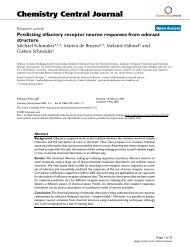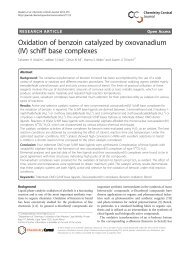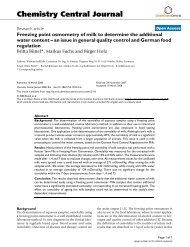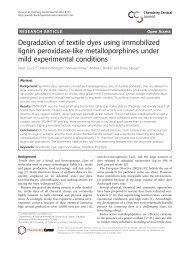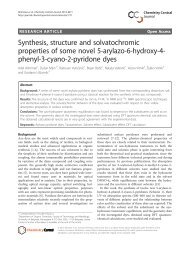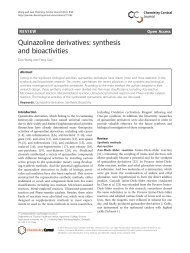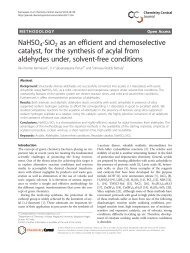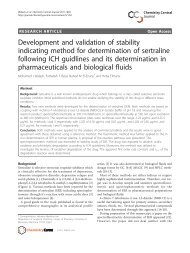Python algorithms in particle tracking microrheology - Chemistry ...
Python algorithms in particle tracking microrheology - Chemistry ...
Python algorithms in particle tracking microrheology - Chemistry ...
Create successful ePaper yourself
Turn your PDF publications into a flip-book with our unique Google optimized e-Paper software.
Maier and Haraszti <strong>Chemistry</strong> Central Journal 2012, 6:144<br />
http://journal.chemistrycentral.com/content/6/1/144<br />
SOFTWARE<br />
Open Access<br />
<strong>Python</strong> <strong>algorithms</strong> <strong>in</strong> <strong>particle</strong> track<strong>in</strong>g<br />
<strong>microrheology</strong><br />
Timo Maier 1,2 and Tamás Haraszti 1,2*<br />
Abstract<br />
Background: Particle track<strong>in</strong>g passive <strong>microrheology</strong> relates recorded trajectories of microbeads, embedded <strong>in</strong> soft<br />
samples, to the local mechanical properties of the sample. The method requires <strong>in</strong>tensive numerical data process<strong>in</strong>g<br />
and tools allow<strong>in</strong>g control of the calculation errors.<br />
Results: We report the development of a software package collect<strong>in</strong>g functions and scripts written <strong>in</strong> <strong>Python</strong> for<br />
automated and manual data process<strong>in</strong>g, to extract viscoelastic <strong>in</strong>formation about the sample us<strong>in</strong>g recorded <strong>particle</strong><br />
trajectories. The result<strong>in</strong>g program package analyzes the fundamental diffusion characteristics of <strong>particle</strong> trajectories<br />
and calculates the frequency dependent complex shear modulus us<strong>in</strong>g methods published <strong>in</strong> the literature. In order<br />
to <strong>in</strong>crease conversion accuracy, segmentwise, double step, range-adaptive fitt<strong>in</strong>g and dynamic sampl<strong>in</strong>g <strong>algorithms</strong><br />
are <strong>in</strong>troduced to <strong>in</strong>terpolate the data <strong>in</strong> a spl<strong>in</strong>elike manner.<br />
Conclusions: The presented set of <strong>algorithms</strong> allows for flexible data process<strong>in</strong>g for <strong>particle</strong> track<strong>in</strong>g <strong>microrheology</strong>.<br />
The package presents improved <strong>algorithms</strong> for mean square displacement estimation, controll<strong>in</strong>g effects of frame loss<br />
dur<strong>in</strong>g record<strong>in</strong>g, and a novel numerical conversion method us<strong>in</strong>g segmentwise <strong>in</strong>terpolation, decreas<strong>in</strong>g the<br />
conversion error from about 100% to the order of 1%.<br />
Keywords: Particle track<strong>in</strong>g <strong>microrheology</strong>, Numerical conversion method, Software library, Dynamic <strong>in</strong>terpolation<br />
Background<br />
Particle track<strong>in</strong>g <strong>microrheology</strong> is a modern tool to <strong>in</strong>vestigate<br />
the viscoelastic properties of soft matter, for example,<br />
biopolymers and the <strong>in</strong>terior, or the membrane of<br />
liv<strong>in</strong>g cells [1,2] on the microscopic scale. Though embedd<strong>in</strong>g<br />
tracer <strong>particle</strong>s <strong>in</strong>to such a sample alters the local<br />
structure, this method is still considered non-<strong>in</strong>vasive and<br />
provides important <strong>in</strong>formation not available by other<br />
methods [1-4].<br />
The physical background of the method lies <strong>in</strong> the thermal<br />
motion of the tracer <strong>particle</strong>, which can be connected<br />
to the viscoelastic properties of the local environment<br />
through the generalized Langev<strong>in</strong> equation [5,6]. Neglect<strong>in</strong>g<br />
the <strong>in</strong>ertia term, which contributes to frequencies<br />
<strong>in</strong> the megahertz range, and assum<strong>in</strong>g that the memory<br />
function is l<strong>in</strong>early related to the frequency dependent<br />
*Correspondence: tamas.haraszti@uni-heidelberg.de<br />
1 Max-Planck Institute for Intelligent Systems, Advanced Materials and<br />
Biosystems, Heisenberg str. 3, 70569 Stuttgart, Germany<br />
2 Biophysical <strong>Chemistry</strong>, Institute of Physical <strong>Chemistry</strong>, University of<br />
Heidelberg, Im Neuenheimer Feld 253, 69120 Heidelberg, Germany<br />
viscosity of the medium (through a generalized Stokes-<br />
E<strong>in</strong>ste<strong>in</strong> relation)[3,5-8], the mean square displacement<br />
(MSD) of the <strong>particle</strong> can be directly related to the creep<br />
compliance as:<br />
J(τ) =<br />
3 πa<br />
N D k B T , (1)<br />
where τ denotes the time step <strong>in</strong> which the <strong>particle</strong> moves<br />
r distance, the mean square displacement,<br />
N D the dimensionality of the motion (usually N D = 2for<br />
<strong>particle</strong> track<strong>in</strong>g digital microscopy), k B the Boltzmann<br />
constant, T is the absolute temperature and a the <strong>particle</strong><br />
radius, respectively.<br />
Active <strong>microrheology</strong> (us<strong>in</strong>g optical or magnetic tweezers)<br />
and macroscopic rheometry commonly characterize<br />
the sample elasticity with the frequency-dependent complex<br />
shear modulus, G ∗ (ω), which is a complex quantity<br />
[4,9,10]. Its real part is known as the storage modulus<br />
G ′ (ω) and the imag<strong>in</strong>ary part is the loss modulus, G ′′ (ω).<br />
While J(t) is a description <strong>in</strong> the time doma<strong>in</strong>, G ∗ (ω) is<br />
an equivalent characterization <strong>in</strong> the frequency doma<strong>in</strong>.<br />
© 2012 Maier and Haraszti; licensee <strong>Chemistry</strong> Central Ltd. This is an Open Access article distributed under the terms of the<br />
Creative Commons Attribution License (http://creativecommons.org/licenses/by/2.0), which permits unrestricted use,<br />
distribution, and reproduction <strong>in</strong> any medium, provided the orig<strong>in</strong>al work is properly cited.
Maier and Haraszti <strong>Chemistry</strong> Central Journal 2012, 6:144 Page 2 of 9<br />
http://journal.chemistrycentral.com/content/6/1/144<br />
The two types of description are equivalent and <strong>in</strong>terconnected<br />
with the relation:<br />
G ∗ (ω) = 1<br />
iω˜J(ω) , (2)<br />
where ˜J(ω) is the Fourier transform of J(t). Assum<strong>in</strong>g that<br />
the <strong>particle</strong> tracks are previously obta<strong>in</strong>ed, the frequency<br />
dependent complex shear modulus G ∗ (ω) can be derived<br />
us<strong>in</strong>g equations (1) and (2) after calculat<strong>in</strong>g the mean<br />
square displacement.<br />
There are two major algorithm libraries available on the<br />
Interned address<strong>in</strong>g data handl<strong>in</strong>g for <strong>microrheology</strong>: the<br />
algorithm collection of J. Crocker et al. written <strong>in</strong> the<br />
<strong>in</strong>teractive data language (IDL) [11], which was translated<br />
to Matlab and expanded by the Kilfoil lab [12]. A separate<br />
stand alone algorithm is provided by M. Tassieri for<br />
calculat<strong>in</strong>g the complex shear modulus from the creep<br />
compliance, written <strong>in</strong> LabView [13]. However, an extensible<br />
<strong>in</strong>tegrated framework rely<strong>in</strong>g on freely accessible<br />
software and source code <strong>in</strong>tegrat<strong>in</strong>g multiple conversion<br />
methods is not yet available.<br />
In this paper we present a software package written <strong>in</strong><br />
the <strong>in</strong>terpreted program<strong>in</strong>g language <strong>Python</strong> (http://www.<br />
python.org) collect<strong>in</strong>g functions to support <strong>particle</strong> track<strong>in</strong>g<br />
<strong>microrheology</strong> related calculations, with emphasis on<br />
those parts provid<strong>in</strong>g enhanced functionality. This library<br />
is meant to be an open source, platform <strong>in</strong>dependent,<br />
freely extendable set of <strong>algorithms</strong> allow<strong>in</strong>g to extract<br />
rheology <strong>in</strong>formation from <strong>particle</strong> tracks obta<strong>in</strong>ed<br />
previously.<br />
The Rheology software library conta<strong>in</strong>s two example<br />
scripts. One called ProcessRheology.py, a configuration<br />
driven program perform<strong>in</strong>g all process<strong>in</strong>g steps from <strong>particle</strong><br />
trajectory <strong>in</strong>puts, thus present<strong>in</strong>g the various capabilities<br />
of the library (Figure 1). This program can be<br />
employed as a self-stand<strong>in</strong>g calculator or its code can<br />
be used as a template for the user test<strong>in</strong>g the Rheology<br />
library. The other is the Function-test.py, conta<strong>in</strong><strong>in</strong>g test<br />
calculations, and which was also employed to produce the<br />
figures <strong>in</strong> this article (see the content of the Additional<br />
file 1).<br />
Implementation<br />
Dependencies<br />
The software depends on the follow<strong>in</strong>g <strong>Python</strong> packages<br />
for calculations and display<strong>in</strong>g results:<br />
• Numpy: a library for array manipulation and<br />
calculations [14];<br />
• Scipy: the <strong>Python</strong> scientific library, from which we<br />
used the gamma function and the nonl<strong>in</strong>ear least<br />
squares fitt<strong>in</strong>g function [14];<br />
• Matplotlib: a Matlab-like plott<strong>in</strong>g library to generate<br />
<strong>in</strong>formation graphs of the results [15].<br />
Figure 1 Process flow chart of <strong>microrheology</strong> data. The<br />
fundamental process<strong>in</strong>g steps <strong>in</strong> <strong>particle</strong> track<strong>in</strong>g <strong>microrheology</strong> as<br />
followed by the ProcessRheology.py script. There are several<br />
parameters that may affect the details of the process, <strong>in</strong>clud<strong>in</strong>g the<br />
sampl<strong>in</strong>g <strong>in</strong> the MSD calculation and which way the complex shear<br />
modulus is calculated (see the ma<strong>in</strong> text for details). In this article we<br />
focus ma<strong>in</strong>ly on the later tree steps <strong>in</strong> the process: the MSD<br />
calculation and conversion methods.<br />
After <strong>in</strong>stallation, its functions are available us<strong>in</strong>g follow<strong>in</strong>g<br />
import command with<strong>in</strong> the <strong>in</strong>terpreter or a<br />
<strong>Python</strong> script:<br />
from Rheology import *<br />
Data presentation, data format<br />
Instead of def<strong>in</strong><strong>in</strong>g <strong>in</strong>dividual classes for each data type<br />
(MSD, creep compliance and complex shear modulus), an<br />
alternative technique <strong>in</strong> <strong>Python</strong> is to employ generalized<br />
lists, the so called dictionaries or ‘dicts’. A dict is a conta<strong>in</strong>er<br />
class hold<strong>in</strong>g data which are <strong>in</strong>dexed with arbitrary<br />
keys (marked by quotes <strong>in</strong> this paper). This is a very general<br />
and flexible data structure, which we used for all data<br />
<strong>in</strong> the Rheology package. For example, MSD dicts conta<strong>in</strong><br />
keys “tau” and “MSD” referr<strong>in</strong>g to arrays hold<strong>in</strong>g the time<br />
lag and the mean square displacement data, respectively.<br />
Particle trajectories<br />
Particle track<strong>in</strong>g <strong>microrheology</strong> starts with the imag<strong>in</strong>g<br />
experiments and the image treatment <strong>in</strong> a strict
Maier and Haraszti <strong>Chemistry</strong> Central Journal 2012, 6:144 Page 3 of 9<br />
http://journal.chemistrycentral.com/content/6/1/144<br />
sense, however, obta<strong>in</strong><strong>in</strong>g <strong>particle</strong> trajectories from video<br />
microscopy is well described <strong>in</strong> the literature [16-20]<br />
<strong>in</strong>clud<strong>in</strong>g the statistical difficulties of the process [21-23].<br />
There are various implementations of <strong>particle</strong> track<strong>in</strong>g<br />
<strong>algorithms</strong> available <strong>in</strong> IDL (see the same website as<br />
for the rheology code) [11,24], Matlab [12,25], LabView<br />
[20,26] or C++ languages [27]. An implementation of the<br />
Grier method [16] is also translated to <strong>Python</strong> [28].<br />
Thus, we start our discussion by extract<strong>in</strong>g rheological<br />
<strong>in</strong>formation from the <strong>particle</strong> trajectories, leav<strong>in</strong>g the<br />
implementation of data <strong>in</strong>put/output to the user. As a<br />
good start<strong>in</strong>g template, we recommend the ReadTable()<br />
and SaveTable() functions <strong>in</strong> the ProcessRheology.py example<br />
script.<br />
Drift correction<br />
Several experimental systems show a drift: a slow oriented<br />
motion of the sample versus the imag<strong>in</strong>g frame, which is<br />
caused by various factors of the experiment<strong>in</strong>g apparatus.<br />
To remove this drift, which is <strong>in</strong>dependent of the sample,<br />
there are multiple possibilities one may consider. If a<br />
reference bead bound to the sample is available, its trajectory<br />
provides the drift itself. If multiple <strong>particle</strong>s are<br />
tracked <strong>in</strong> the same time <strong>in</strong>terval, an average trajectory<br />
may be calculated and used as a reference. If these possibilities<br />
are not available, one has to consider whether<br />
the long time motion is due to drift or it is a characteristic<br />
of the <strong>in</strong>vestigated sample, because subtract<strong>in</strong>g it<br />
changes the resulted long time lag (low frequency) part of<br />
the viscoelastic characteristics.<br />
The simplest way of data treatment <strong>in</strong> such cases is<br />
to calculate a smoothened trajectory: e. g. us<strong>in</strong>g a runn<strong>in</strong>g<br />
average, and either subtract this smoothened data<br />
or, <strong>in</strong> one further step, fit a low order polynomial to the<br />
smoothened data and subtract the fitted values from the<br />
trajectory.<br />
A very simple implementation is available for two<br />
dimensional data sets as:<br />
GetData(timestamps, poslist, <strong>in</strong>dx=0,<br />
order=3,resolution=0.1434, Nd= 1000)<br />
This algorithm takes a position list (parameter poslist),<br />
which is a list of dicts, each describ<strong>in</strong>g the positions of a<br />
<strong>particle</strong>. The <strong>in</strong>dx parameter is used to select one of them.<br />
A position dict conta<strong>in</strong>s “X”, and “Y”, which are arrays of<br />
the x and y positions.Thedictalsoconta<strong>in</strong>san<strong>in</strong>dex<br />
array denoted with key “<strong>in</strong>dx”, identify<strong>in</strong>g the image <strong>in</strong>dex<br />
(serial number) of the given positions. Us<strong>in</strong>g this <strong>in</strong>dex<br />
allows the track<strong>in</strong>g algorithm to miss <strong>in</strong>dividual frames (e.<br />
g. when the <strong>particle</strong> drifted out of focus). This <strong>in</strong>dex is also<br />
used to def<strong>in</strong>e the time po<strong>in</strong>t of a position, either by identify<strong>in</strong>g<br />
the correspond<strong>in</strong>g time stamps, provided <strong>in</strong> seconds<br />
<strong>in</strong> the timestamps array, or if this variable is set to None,<br />
multiply<strong>in</strong>g the <strong>in</strong>dex by the optional tscale parameter.<br />
The Nd parameter gives the number of po<strong>in</strong>ts used <strong>in</strong> the<br />
runn<strong>in</strong>g average and the order parameter identifies the<br />
order of the polynomial to be fitted for drift correction. If<br />
Nd is set to −1, the runn<strong>in</strong>g averag<strong>in</strong>g is off, and if order is<br />
-1, the drift correction is turned off. The resolution is used<br />
to scale the coord<strong>in</strong>ates to micrometers (the same value<br />
for both coord<strong>in</strong>ates).<br />
Mean square displacement (MSD)<br />
Characteriz<strong>in</strong>g a soft sample us<strong>in</strong>g <strong>particle</strong> track<strong>in</strong>g<br />
<strong>microrheology</strong> strongly relies on the determ<strong>in</strong>ation of<br />
the mean square displacement. Calculat<strong>in</strong>g the MSD has<br />
two possible sets of assumptions: 1.) ensemble averages<br />
are based on record<strong>in</strong>g many tracer <strong>particle</strong>s and assum<strong>in</strong>g<br />
homogeneity across the sample. This is the averag<strong>in</strong>g<br />
method considered <strong>in</strong> theories, and has the advantage<br />
allow<strong>in</strong>g estimation of the time-dependent ag<strong>in</strong>g of the<br />
system. Technically this can be achieved by us<strong>in</strong>g video<br />
record<strong>in</strong>g-based <strong>particle</strong> track<strong>in</strong>g, where the number of<br />
tracers can be <strong>in</strong>creased to the order of tens. 2.) Assum<strong>in</strong>g<br />
ergodicity, one can switch from ensemble averag<strong>in</strong>g to<br />
time averag<strong>in</strong>g. This is very important for systems which<br />
are not homogeneous and for cases where only few <strong>particle</strong>s<br />
(1 − 5) can be observed at a time. For samples of<br />
biological orig<strong>in</strong>, time averag<strong>in</strong>g is more suitable because<br />
these samples are seldom homogeneous.<br />
Calculat<strong>in</strong>g the time average is done by splitt<strong>in</strong>g up the<br />
trajectory <strong>in</strong>to non-overlapp<strong>in</strong>g parts and averag<strong>in</strong>g their<br />
displacement.Becausethenumberof<strong>in</strong>tervalsdecreases<br />
with an <strong>in</strong>creas<strong>in</strong>g lag time, this method has very high<br />
error for large lag time values. Alternatively, it is also possible<br />
to split the trajectory <strong>in</strong>to overlapp<strong>in</strong>g regions and<br />
then do the averag<strong>in</strong>g. The result<strong>in</strong>g statistical errors follow<br />
a non-normal distribution, but it has been shown that<br />
us<strong>in</strong>g overlapp<strong>in</strong>g segments the resulted MSD may show<br />
improved accuracy [29,30] when us<strong>in</strong>g lag time values up<br />
to about the quarter of the measurement length (N/4 for<br />
N data po<strong>in</strong>ts). The results of a test calculation us<strong>in</strong>g positions<br />
randomly calculated from a normal distribution with<br />
standard deviation of σ X = σ Y = 0.15 μm <strong>in</strong> both X and<br />
Y directions are presented <strong>in</strong> Figure 2. The MSD oscillates<br />
around the theoretical value of = 2(σ 2 X +<br />
σ 2 Y ) = 0.09 μm2 as expected, but the data calculated us<strong>in</strong>g<br />
overlapp<strong>in</strong>g <strong>in</strong>tervals show visibly better accuracy.<br />
msd = MSD(positionlist, tau= 0)<br />
MSD() is the function to calculate the mean square displacement<br />
from a s<strong>in</strong>gle trajectory. The data po<strong>in</strong>ts are<br />
presented as a two dimensional array positionlist,conta<strong>in</strong><strong>in</strong>g<br />
coord<strong>in</strong>ates ((x, y) or (x, y, z)) <strong>in</strong> each row.<br />
The second parameter (tau) is used to generate the lag<br />
time values (steps) for which the MSD is calculated. This
Maier and Haraszti <strong>Chemistry</strong> Central Journal 2012, 6:144 Page 4 of 9<br />
http://journal.chemistrycentral.com/content/6/1/144<br />
MSD, μm 2<br />
1<br />
0.1<br />
0.01<br />
0.001<br />
0.01 0.1 1 10 100<br />
τ, seconds<br />
Figure 2 mean square displacement data calculated from<br />
simulated data. The distribution of X and Y positions were generated<br />
based on a normal distribution with σ = 0.15 μm. The theoretical<br />
MSD is constant at 0.09 μm 2 (black l<strong>in</strong>e). Data with non-overlapp<strong>in</strong>g<br />
<strong>in</strong>tervals (red + symbols) show higher scatter<strong>in</strong>g, the ones calculated<br />
with overlapp<strong>in</strong>g <strong>in</strong>tervals (green ×) show a much lower error.<br />
parameter can take various values: If an array or list of<br />
<strong>in</strong>teger values are given, then those are used as <strong>in</strong>dex step<br />
values. If a s<strong>in</strong>gle <strong>in</strong>teger is given between 0 and the number<br />
of positions, then so many <strong>in</strong>dex steps (lag time values)<br />
are generated <strong>in</strong> an equidistant manner. If noth<strong>in</strong>g, or 0 is<br />
given, then values 1 ...N/4areused.<br />
Each tau value results <strong>in</strong> M = M(tau) pairs, where<br />
the step r[ i + tau] −r[ i]iscalculated.M also depends on<br />
whether the set was generated us<strong>in</strong>g overlapp<strong>in</strong>g <strong>in</strong>tervals<br />
(if overlap = True is set).<br />
If an array of time values (<strong>in</strong> seconds) are provided for<br />
the position data us<strong>in</strong>g the optional tvector parameter, the<br />
algorithm will check the time step between each data pair<br />
used. Calculat<strong>in</strong>g the mean value of these time steps and<br />
us<strong>in</strong>g a relative error, every value outside the mean (1 ±<br />
tolerance) will be ignored (by default tolerance = 0.1).<br />
This process elim<strong>in</strong>ates jumps <strong>in</strong> the data caused by computer<br />
latency dur<strong>in</strong>g record<strong>in</strong>g.<br />
The function returns a dictionary conta<strong>in</strong><strong>in</strong>g “tau”,<br />
“dtau”,“MSD”,“DMSD”keys.Ifthetimevalueswerenot<br />
provided, then “tau” holds the <strong>in</strong>dex steps between the<br />
positions and “dtau” is not used.<br />
Creep compliance<br />
Assum<strong>in</strong>g that the generalized Stokes-E<strong>in</strong>ste<strong>in</strong> relation<br />
holds, the creep compliance is l<strong>in</strong>early proportional to the<br />
MSD [6]. The MSD to J() function calculates the creep<br />
compliance us<strong>in</strong>g equation (1).<br />
J = MSD to J(msd, t0= 0.1, tend= 150,<br />
T= 25.0, a= 1.0)<br />
The calculation requires a dict structure (msd) hav<strong>in</strong>g<br />
thetimevaluesunderthe“tau”key,andtheMSDvalues<br />
under the “MSD” key (error values are optional). Further<br />
parameters are the temperature T of the experiment <strong>in</strong><br />
Celsius degrees, the radius a oftheappliedtracer<strong>particle</strong><br />
<strong>in</strong> micrometers, and optionally the dimensionality of the<br />
motion D (denoted as N D <strong>in</strong> equation (1)), which is set to<br />
D = 2 by default.<br />
Calculat<strong>in</strong>g the frequency dependent shear modulus<br />
from J(t) with the numerical method proposed by Evans<br />
et al. requires extrapolated values to the zero time po<strong>in</strong>t<br />
and to <strong>in</strong>f<strong>in</strong>ite time values. These values are estimated<br />
here, allow<strong>in</strong>g the user to override them before be<strong>in</strong>g used<br />
to calculate the complex shear modulus G ∗ (ω). Thezero<br />
time value J 0 = J(t = 0) is extrapolated from a l<strong>in</strong>ear fit<br />
<strong>in</strong> the t < t0 region, and the end extrapolation is obta<strong>in</strong>ed<br />
from a l<strong>in</strong>ear fit to the tend < t part.Theslopeofthe<br />
extrapolated end part is 1/η, whereη is the steady state<br />
viscosity [31].<br />
The function returns a new dict conta<strong>in</strong><strong>in</strong>g: “J” (<strong>in</strong><br />
1/Pa), “tau”, “eta”, “J0”, “const”, “dJ”, and the fit parameters<br />
as “a0”, “b0” for the first part and “a1”, “b1” for the end part,<br />
where the l<strong>in</strong>ear equation J = a i t + b i (i = 0, 1) holds.<br />
Calculat<strong>in</strong>g the frequency dependent complex shear modulus<br />
While the connection presented by equation (2) is simple,<br />
there is a major problem with determ<strong>in</strong><strong>in</strong>g ˜J(ω) numerically.Itiswellknown<strong>in</strong>numericalanalysisthatapply<strong>in</strong>g<br />
a numerical Fourier transform <strong>in</strong>creases the experimental<br />
noise enormously [32]. In <strong>microrheology</strong>, there are<br />
four commonly applied methods to solve this problem.<br />
The first two address the noise of the Fourier transform<br />
directly by averag<strong>in</strong>g or by fitt<strong>in</strong>g, the second two were<br />
suggested <strong>in</strong> the last decade to improve the transform<br />
itself [6,9,31-33].<br />
In a homogeneous system, where multiple <strong>particle</strong>s can<br />
be tracked, convert<strong>in</strong>g their MSD to creep compliance and<br />
then G ∗ (ω) us<strong>in</strong>g a discrete Fourier transform, allows one<br />
to average the converted values and decrease the noise<br />
this way [32,33]. For cases when the creep compliance can<br />
be modeled us<strong>in</strong>g an analytical form, the Fourier transform<br />
of the fitted analytical function may be calculated<br />
and used to estimate of G ∗ (ω) [9].<br />
As we have discussed above, samples of biological orig<strong>in</strong><br />
are often not homogeneous and their MSD does not follow<br />
a well-described analytical function. However, model<br />
calculations suggest, <strong>in</strong> agreement with experiments, that<br />
biopolymers and many polymer gels show power law<br />
behavior at various time ranges [34-36]. The third and<br />
fourth conversion approaches have been suggested for<br />
such systems <strong>in</strong> the <strong>microrheology</strong> literature. One uses<br />
a power law approximation of the MSD or the creepcompliance<br />
[6] (we shall call the Mason method), and the<br />
other calculates a l<strong>in</strong>ear <strong>in</strong>terpolation between the data<br />
po<strong>in</strong>ts and apply<strong>in</strong>g a discrete Fourier transform on it [31]<br />
(we shall cite as the Evans method).
Maier and Haraszti <strong>Chemistry</strong> Central Journal 2012, 6:144 Page 5 of 9<br />
http://journal.chemistrycentral.com/content/6/1/144<br />
Because these methods have their strength and weakness,<br />
we summarize them and their implementation<br />
below. Recently we have shown that the accuracy of the<br />
Evans method can be greatly improved by us<strong>in</strong>g local<br />
<strong>in</strong>terpolation of the data <strong>in</strong> a spl<strong>in</strong>elike manner without<br />
forc<strong>in</strong>g a s<strong>in</strong>gle function to be fitted to the whole data<br />
set. This improvement is also <strong>in</strong>cluded <strong>in</strong> the Rheology<br />
framework and will be discussed below.<br />
The Mason method<br />
This is a fast conversion method based on the Fourier<br />
transformation of a power function, which has been used<br />
<strong>in</strong> various works <strong>in</strong> the last decade [6-8,37-39]. Briefly,<br />
let us consider a generalized diffusion process, where the<br />
MSD is follow<strong>in</strong>g a power law: < r(t) 2 >= 2N D Dt α<br />
[40], where D is the generalized diffusion coefficient, and<br />
0
Maier and Haraszti <strong>Chemistry</strong> Central Journal 2012, 6:144 Page 6 of 9<br />
http://journal.chemistrycentral.com/content/6/1/144<br />
J 0 and η are already estimated us<strong>in</strong>g the l<strong>in</strong>ear fits <strong>in</strong><br />
the MSD to J() function. Us<strong>in</strong>g equation (5) is straightforward,<br />
and allow for the calculation of G ∗ (ω) at any ω<br />
values. The natural selection of a suitable frequency range<br />
would be from 0 to N<br />
T π (the unit is 1/s) <strong>in</strong>N/2 stepsas<br />
it is common for the discrete Fourier transform of equally<br />
sampled data [32]. The correspond<strong>in</strong>g function is:<br />
G = J to G(J)<br />
The algorithm generates a l<strong>in</strong>ear array of frequencies,<br />
but the number of po<strong>in</strong>ts is limited to be maximum 1000,<br />
usually more than sufficient (MSD and creep compliance<br />
data arrays may hold several thousand po<strong>in</strong>ts). The result<br />
is a similar dictionary as it was for the Mason method,<br />
and can be tested us<strong>in</strong>g a Maxwell-fluid, which has a l<strong>in</strong>ear<br />
creep compliance <strong>in</strong> the form of J(t) = 1/E + t/η<br />
(Figure 4).<br />
There are various details worth mention<strong>in</strong>g about this<br />
method, which may affect the accuracy of the result <strong>in</strong><br />
general cases. It is clear <strong>in</strong> equation (5), that the method is<br />
sensitive to the A k+1 − A k terms, which, <strong>in</strong> extreme cases,<br />
may be either very small for a nearly l<strong>in</strong>ear part of J(t) or<br />
very high for sudden jumps <strong>in</strong> the experimental data. In<br />
order to reduce round-off errors, one may elim<strong>in</strong>ate the<br />
closetozerovalues,(when|A k+1 − A k |
Maier and Haraszti <strong>Chemistry</strong> Central Journal 2012, 6:144 Page 7 of 9<br />
http://journal.chemistrycentral.com/content/6/1/144<br />
1. def<strong>in</strong>e the data range us<strong>in</strong>g <strong>in</strong>dices i 0 = 0 and<br />
i 1 = i(t 0 ), conta<strong>in</strong><strong>in</strong>g at least 4 data po<strong>in</strong>ts;<br />
2. fit function from i 0 ...i 1 , calculate the squared error<br />
of each po<strong>in</strong>t and estimate the average error;<br />
3. f<strong>in</strong>d the last po<strong>in</strong>t around i 1 where χ 2 (i 2 )
Maier and Haraszti <strong>Chemistry</strong> Central Journal 2012, 6:144 Page 8 of 9<br />
http://journal.chemistrycentral.com/content/6/1/144<br />
100<br />
Additional file<br />
G’, G’’, Pa<br />
10<br />
1<br />
Additional file 1: rheology.zip - compressed ZIP archive conta<strong>in</strong><strong>in</strong>g<br />
the Rheology <strong>Python</strong> package. The archive conta<strong>in</strong>s several files. The<br />
source code <strong>in</strong> the Rheology subfolder, a setup.py for <strong>in</strong>stallation,<br />
README.txt and License.txt files and the Example subfolder. Installation (as<br />
usual <strong>in</strong> python):<br />
python setup.py build; python setup.py <strong>in</strong>stall<br />
0.1<br />
0.01<br />
0.1 1 10 100 1000<br />
ω, 1/s<br />
Figure 6 Dynamic resampl<strong>in</strong>g. Dynamic resampl<strong>in</strong>g can correct the<br />
errors of the Evans method result<strong>in</strong>g <strong>in</strong> an improved fit. The storage<br />
modulus (red +) and loss modulus (green ×) data calculated<br />
numerically shows a good fit to the theoretically predicted values<br />
(black l<strong>in</strong>es).<br />
The Example subfolder conta<strong>in</strong>s two <strong>Python</strong> scripts. The Function-test.py<br />
can be used to run test calculations and see the example plots present<strong>in</strong>g<br />
that all functions work properly. The figures presented <strong>in</strong> this paper were<br />
also generated by this script.<br />
The ProcessRheology.py is a batch process<strong>in</strong>g script, controlled by<br />
commands and parameters provided <strong>in</strong> a config.txt pla<strong>in</strong> text file. An<br />
example of this file is also <strong>in</strong>cluded here, conta<strong>in</strong><strong>in</strong>g detailed description of<br />
every parameter. This scripts is a fully function<strong>in</strong>g <strong>microrheology</strong> data<br />
evaluation toolkit, utiliz<strong>in</strong>g the functions of the Rheology package.<br />
Abbreviations<br />
MSD, Mean square displacement.<br />
Compet<strong>in</strong>g <strong>in</strong>terests<br />
The Authors declare that they have not compet<strong>in</strong>g <strong>in</strong>terests.<br />
def<strong>in</strong>ed by the NSmooth parameter. The range is identified<br />
<strong>in</strong> the orig<strong>in</strong>al data, but then applied to the ref<strong>in</strong>ed<br />
data set. The result is an MSD, where sudden jumps are<br />
reduced, m<strong>in</strong>imiz<strong>in</strong>g the presence of oscillatory artifacts<br />
<strong>in</strong> the resulted complex shear modulus G ∗ (ω).<br />
Conclusions<br />
Inthispaperwehavepresentedafreesoftwaresolution<br />
for analyz<strong>in</strong>g <strong>particle</strong> track<strong>in</strong>g data for <strong>microrheology</strong>.<br />
Our software library implements the time average calculation<br />
of mean square displacement with control over the<br />
time shift <strong>in</strong> the data, and conversion methods to calculate<br />
the creep compliance and the complex shear modulus.<br />
Beyond the two most common methods mentioned <strong>in</strong> the<br />
literature, we have developed a dynamic local fitt<strong>in</strong>g procedure,<br />
which allows spl<strong>in</strong>e-like fitt<strong>in</strong>g of the MSD and<br />
improved conversion accuracy to about 1% from about<br />
100% for a Kelv<strong>in</strong>-Voigt model test.<br />
Availability and requirements<br />
Lists the follow<strong>in</strong>g:<br />
• Project name: Rheology for <strong>Python</strong><br />
• Project home page: http://launchpad.net/<br />
<strong>microrheology</strong>py/<br />
• Operat<strong>in</strong>g systems: Platform <strong>in</strong>dependent (L<strong>in</strong>ux,<br />
W<strong>in</strong>dows and Max OSX tested)<br />
• Program<strong>in</strong>g language: <strong>Python</strong> 2.7<br />
• Other requirements: Numpy 1.5, Scipy 0.1,<br />
Matplotlib 1.0<br />
• License: LGPL v3<br />
• Any restrictions to use by non-academics: see<br />
license<br />
Authors’ contributions<br />
TM and TH have developed the <strong>Python</strong> software together discuss<strong>in</strong>g and<br />
test<strong>in</strong>g the various features, and both contributed to writ<strong>in</strong>g this manuscript.<br />
Both authors read and approved the f<strong>in</strong>al manuscript.<br />
Acknowledgements<br />
This work was supported by the M<strong>in</strong>istry of Science, Research, and the Arts of<br />
Baden-Württemberg (AZ:720.830-5-10a). The authors would like to thank to<br />
Professor Dr. Joachim P. Spatz, Dr. Heike Boehm and the Max-Planck Society<br />
for the generous f<strong>in</strong>ancial support and Dr. Claire Cobley for assistance.<br />
Received: 13 September 2012 Accepted: 14 November 2012<br />
Published: 27 November 2012<br />
References<br />
1. Dangaria JHH, Butler PJJ: Macrorheology and adaptive <strong>microrheology</strong><br />
of endothelial cells subjected to fluid shear stress. Am J Physiol Cell<br />
Physiol 2007, 293:C1568—C1575.<br />
2. Bausch AR, Moller W, Sackmann E: Measurement of local viscoelasticity<br />
and forces <strong>in</strong> liv<strong>in</strong>g cells by magnetic tweezers. Biophys J 1999,<br />
76:573–579.<br />
3. Waigh TA: Microrheology of complex fluids. Rep Prog Phys 2005,<br />
68(3):685.<br />
4. Wirtz D: Particle-track<strong>in</strong>g <strong>microrheology</strong> of liv<strong>in</strong>g cells: pr<strong>in</strong>ciples<br />
and applications. Annu Rev Biophys 2009, 38:301–326.<br />
5. Mason TG, Weitz DA: Optical measurements of frequency-dependent<br />
l<strong>in</strong>ear viscoelastic moduli of complex fluids. Phys Rev Lett 1995,<br />
74(7):1250–1253.<br />
6. Mason TG, Ganesan K, van Zanten JH, Wirtz D, Kuo SC: Particle track<strong>in</strong>g<br />
<strong>microrheology</strong> of complex fluids. Phys Rev Lett 1997, 79:3282 – 3285.<br />
7. Mason TG: Estimat<strong>in</strong>g the viscoelastic moduli of complex fluids us<strong>in</strong>g<br />
the generalized Stokes-E, <strong>in</strong>ste<strong>in</strong> equation. Rheologica Acta 2000,<br />
39(4):371–378.<br />
8. Squires TM, Mason TG: Fluid mechanics of <strong>microrheology</strong>. Annu Rev<br />
Fluid Mech 2010, 42:413–438.<br />
9. Goodw<strong>in</strong> JW, Hughes RW: Rheology for Chemists. An Introduction.Second<br />
edition. Cambridge: RSC Publish<strong>in</strong>g; 2008.<br />
10. Mezger TG: The Rheology Handbook. 3rd revised edition. V<strong>in</strong>centz Network<br />
GmbH & Co. KG , Plathnerstr. 4c, Vol. 30175. Hannover, Germany: European<br />
Coat<strong>in</strong>gs Tech Files, V<strong>in</strong>centz Network; 2011.<br />
11. Crocker J, Weeks E: Microrheology tools for IDL . [http://www.physics.<br />
emory.edu/weeks/idl/rheo.html]
Maier and Haraszti <strong>Chemistry</strong> Central Journal 2012, 6:144 Page 9 of 9<br />
http://journal.chemistrycentral.com/content/6/1/144<br />
12. Kilfoil M, et al.: Matlab <strong>algorithms</strong> from the Kilfoil lab. [http://people.<br />
umass.edu/kilfoil/downloads.html]<br />
13. Tassieri M: Compliance to complex moduli, version 2. 2011. [https://<br />
sites.google.com/site/manliotassieri/labview-codes]<br />
14. Jones E, Oliphant T, Peterson P, et al.: SciPy: Open source scientific<br />
tools for <strong>Python</strong>. 2001. [http://www.scipy.org/]<br />
15. Hunter JD: Matplotlib: A 2D graphics environment. Comput Sci Eng<br />
2007, 9(3):90–95. [http://matplotlib.sourceforge.net/]<br />
16. Crocker JC, Grier DG: Methods of digital video microscopy for<br />
colloidal studies. J Colloid Interface Sci 1996, 179:298–310. [http://www.<br />
physics.emory.edu/weeks/idl/]<br />
17. Brangwynne CP, Koender<strong>in</strong>k GH, Barry E, Dogic Z, MacK<strong>in</strong>tosh FC, Weitz<br />
DA: Bend<strong>in</strong>g dynamics of fluctuat<strong>in</strong>g biopolymers probed by<br />
automated high-resolution filament track<strong>in</strong>g. Biophys J 2007,<br />
93:346–359.<br />
18. Gosse C, Croquette V: Magnetic tweezers: micromanipulation and<br />
force measurement at the molecular level. Biophys J 2002,<br />
82(6):3314–3329.<br />
19. Rogers SS, Waigh TA, Lu JR: Intracellular <strong>microrheology</strong> of motile<br />
amoeba proteus. Biophys J 2008, 94(8):3313–3322.<br />
20. Carter BC, Shubeita GT, Gross SP: Track<strong>in</strong>g s<strong>in</strong>gle <strong>particle</strong>s: a<br />
user-friendly quantitative evaluation. Phys Biol 2005, 2:60.<br />
21. Sav<strong>in</strong> T, Doyle PS: Statistical and sampl<strong>in</strong>g issues when us<strong>in</strong>g multiple<br />
<strong>particle</strong> track<strong>in</strong>g. Phys Rev E 2007, 76(2):021501.<br />
22. Sav<strong>in</strong> T, Doyle PS: Static and dynamic errors <strong>in</strong> <strong>particle</strong> track<strong>in</strong>g<br />
<strong>microrheology</strong>. Biophys J 2005, 88:623–638.<br />
23. Sav<strong>in</strong> T, Spicer PT, Doyle PS: A rational approach to noise<br />
discrim<strong>in</strong>ation <strong>in</strong> video microscopy <strong>particle</strong> track<strong>in</strong>g. App Phys Lett<br />
2008, 93(2):024102.<br />
24. Smith R, Spauld<strong>in</strong>g G: User-friendly, freeware image segmentation<br />
and <strong>particle</strong> track<strong>in</strong>g. [http://titan.iwu.edu/gspald<strong>in</strong>/rytrack.html]<br />
25. Blair D, Dufresne E: The Matlab <strong>particle</strong> track<strong>in</strong>g code<br />
respository.:2005 - 2008. [http://physics.georgetown.edu/matlab/]<br />
26. Milne G: Particle track<strong>in</strong>g. 2006. [http://zone.ni.com/devzone/cda/epd/<br />
p/id/948]<br />
27. Caswell TA: Particle identification and track<strong>in</strong>g. [http://jfi.uchicago.<br />
edu/tcaswell/track doc/]<br />
28. Haraszti T: ImageP: image process<strong>in</strong>g add-ons to <strong>Python</strong> and numpy.<br />
2012 2009. [https://launchpad.net/imagep]<br />
29. Flyvbjerg H, Petersen HG: Error estimates on averages of correlated<br />
data. J Chem Phys 1989, 91:461–466.<br />
30. Saxton M: S<strong>in</strong>gle-<strong>particle</strong> track<strong>in</strong>g: the distribution of diffusion<br />
coefficients. Biophys J 1997, 72(4):1744–1753.<br />
31. Evans RML, Tassieri M, Auhl D, Waigh TA: Direct conversion of<br />
rheological compliance measurements <strong>in</strong>to storage and loss<br />
moduli. Phys Rev E 2009, 80:012501.<br />
32. Press WH, Teukolsky SA, Vetterl<strong>in</strong>g WT, FB P: Numerical recipes <strong>in</strong> C++.<br />
second edition. Cambridge: Cambridge University Press; 2002.<br />
33. Addas KM, Schmidt CF, Tang JX: Microrheology of solutions of<br />
semiflexible biopolymer filaments us<strong>in</strong>g laser tweezers<br />
<strong>in</strong>terferometry. Phys Rev E 2004, 70(2):021503.<br />
34. Morse DC: Viscoelasticity of concentrated isotropic solutions of<br />
semiflexible polymers. 2. L<strong>in</strong>ear Response. Macromolecules 1998,<br />
31(20):7044–7067.<br />
35. Morse DC: Viscoelasticity of concentrated isotropic solutions of<br />
semiflexible polymers. 1. model and stress tensor. Macromolecules<br />
1998, 31(20):7030–3043.<br />
36. Gittes F, Schnurr B, Olmsted PD, MacK<strong>in</strong>tosh FC, Schmidt CF: Microscopic<br />
viscoelasticity: shear moduli of soft materials determ<strong>in</strong>ed from<br />
thermal fluctuations. Phys Rev Lett 1997, 79(17):3286–3289.<br />
37. Crocker JC, Valent<strong>in</strong>e MT, Weeks ER, Gisler T, Kaplan PD, Yodh AG, Weitz<br />
DA: Two-po<strong>in</strong>t <strong>microrheology</strong> of <strong>in</strong>homogeneous soft materials.<br />
Phys Rev Lett 2000, 85(4):888–891.<br />
38. Dasgupta BR, Tee SY, Crocker JC, Frisken BJ, Weitz DA: Microrheology of<br />
polyethylene oxide us<strong>in</strong>g diffus<strong>in</strong>g wave spectroscopy and s<strong>in</strong>gle<br />
scatter<strong>in</strong>g. Phys Rev E 2002, 65(5):051505.<br />
39. Cheong F, Duarte S, Lee SH, Grier D: Holographic <strong>microrheology</strong> of<br />
polysaccharides from streptococcus mutans biofilms. Rheologica Acta<br />
2009, 48:109–115.<br />
40. Tejedor V, Benichou O, Voituriez R, Jungmann R, Simmel F,<br />
Selhuber-Unkel C, Oddershede LB, Metzler R: Quantitative analysis of<br />
s<strong>in</strong>gle <strong>particle</strong> trajectories: mean maximal excursion method.<br />
Biophys J 2010, 98(7):1364–1372.<br />
41. Maier T, Boehm H, Haraszti T: Spl<strong>in</strong>elike <strong>in</strong>terpolation <strong>in</strong> <strong>particle</strong><br />
track<strong>in</strong>g <strong>microrheology</strong>. Phys Rev E 2012, 86:011501.<br />
doi:10.1186/1752-153X-6-144<br />
Cite this article as: Maier and Haraszti: <strong>Python</strong> <strong>algorithms</strong> <strong>in</strong> <strong>particle</strong> track<strong>in</strong>g<br />
<strong>microrheology</strong>. <strong>Chemistry</strong> Central Journal 2012 6:144.<br />
Publish with <strong>Chemistry</strong>Central and every<br />
scientist can read your work free of charge<br />
Open access provides opportunities to our<br />
colleagues <strong>in</strong> other parts of the globe, by allow<strong>in</strong>g<br />
anyone to view the content free of charge.<br />
W. Jeffery Hurst, The Hershey Company.<br />
available free of charge to the entire scientific community<br />
peer reviewed and published immediately upon acceptance<br />
cited <strong>in</strong> PubMed and archived on PubMed Central<br />
yours you keep the copyright<br />
Submit your manuscript here:<br />
http://www.chemistrycentral.com/manuscript/




